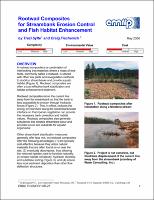Please use this identifier to cite or link to this item:
https://hdl.handle.net/11681/3954| Title: | Rootwad composites for streambank erosion control and fish habitat enhancement |
| Authors: | Sylte, Traci Fischenich, J. Craig, 1962- |
| Keywords: | Riparian areas Erosion Soil stabilization Fishes--Habitat |
| Publisher: | Engineer Research and Development Center (U.S.) |
| Series/Report no.: | Technical Note (Ecosystem Management and Restoration Research Program (U.S.)) ; no. ERDC TN-EMRRP-SR-21 |
| Abstract: | A rootwad composite is a combination of interlocking tree materials where a mass of tree roots, commonly called a rootwad, is utilized with other tree parts and revegetation methods to stabilize streambanks and provide aquatic habitat (Figure 1). Rootwad composites are often a cost-effective bank stabilization and habitat enhancement treatment. Rootwad composites move the current line away from the streambank so that the bank is less susceptible to erosion through hydraulic forces (Figure 2). This, in effect, reduces the energy environment along the streambank/water interface so that riparian vegetation can provide the necessary bank protection and habitat values. Rootwad composites also generate turbulence that creates streambed scour and provides cover and substrate for aquatic organisms. Other streambank stabilization measures generally offer less risk, but rootwad composites offer the following advantages: (1) are typically cost-effective because they utilize natural materials that are often found on or near the site; (2) eventually decompose, thus allowing the restored riparian zone to function naturally, (3) create habitat complexity, hydraulic diversity, and substrate sorting (Figure 3), and (4) induce less local sediment deposition than other flow deflection structures. Rootwad composites, like most bank stabilization treatments, have limitations. Thresholds for allowable shear stress have not been developed, so limits of their applicability have not been well-defined. Field studies suggest that they are susceptible to flanking and that their performance is highly dependent upon their orientation with respect to flow direction. Thus, the use of rootwad composites for erosion control should be limited to conditions where the up- and downstream ends are secured and at least one stable meander sequence exists upstream. However, these requirements do not limit the use of rootwad composites for habitat enhancement or augmenting riparian vegetation restoration. Rootwad composites require a thorough and immediate revegetation plan for complete and long-term project success, and if not constructed properly, fish habitat enhancement values may be less than desired. Finally, if not orientated correctly with respect to current line and scour depth, and if protective measures for flanking are not accounted for, streambank failure may result. |
| Description: | Technical Note |
| Gov't Doc #: | ERDC TN-EMRRP-SR-21 |
| Rights: | Approved for public release; distribution is unlimited |
| URI: | http://hdl.handle.net/11681/3954 |
| Appears in Collections: | Technical Note |
Files in This Item:
| File | Description | Size | Format | |
|---|---|---|---|---|
| ERDC-TN-EMRRP-SR-21.pdf | 1.38 MB | Adobe PDF |  View/Open |